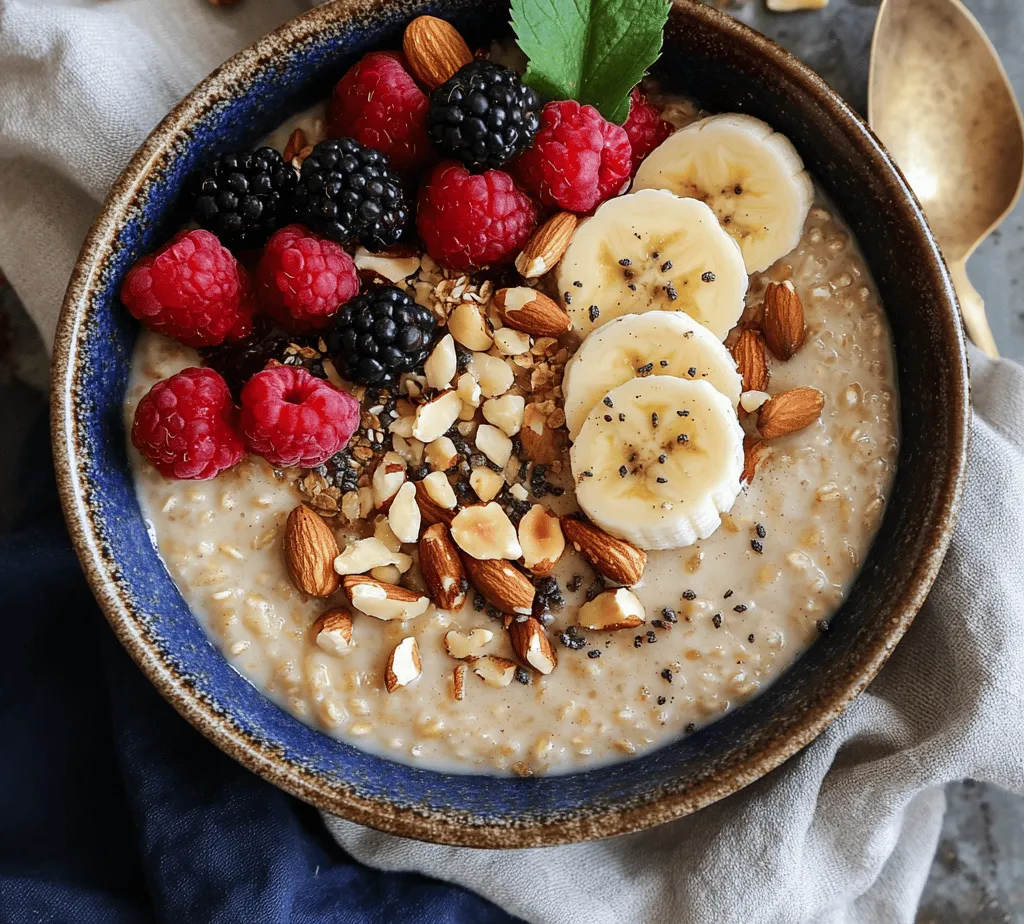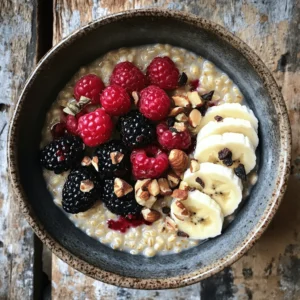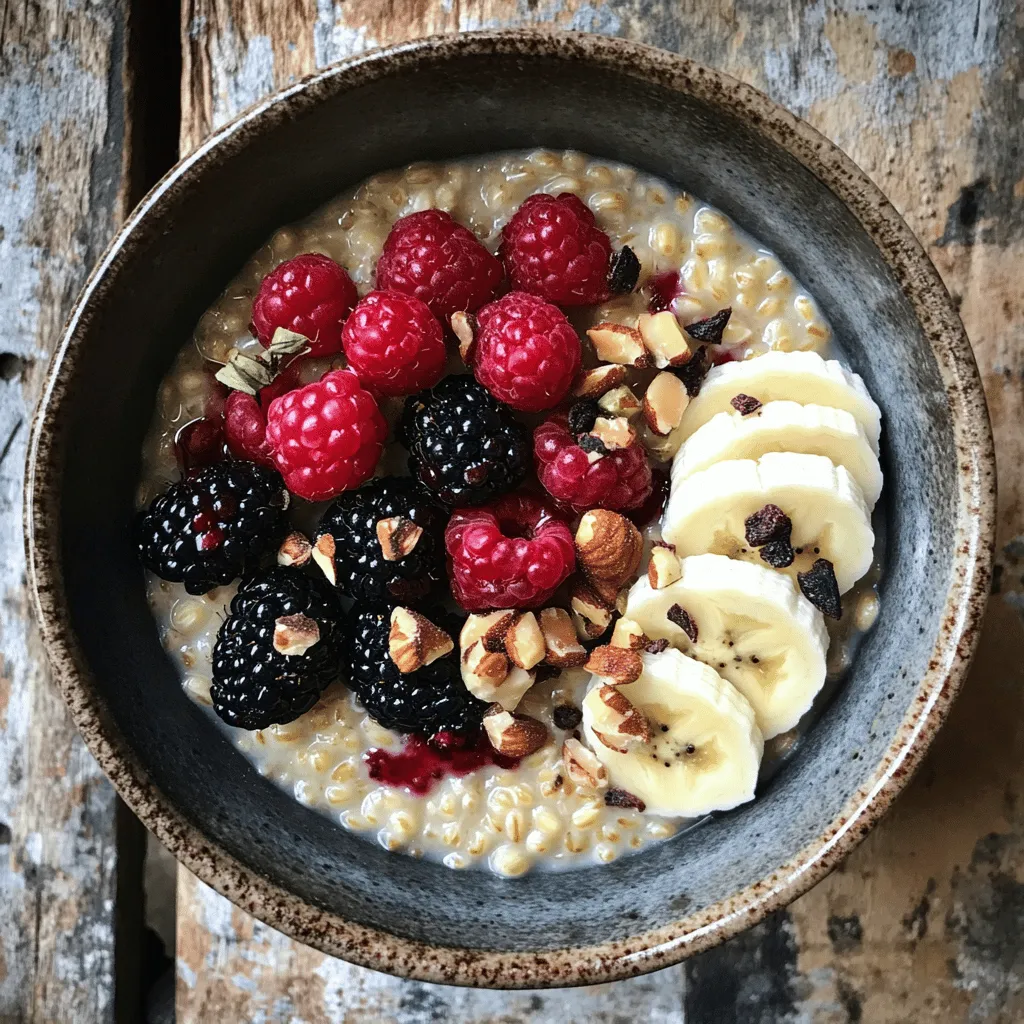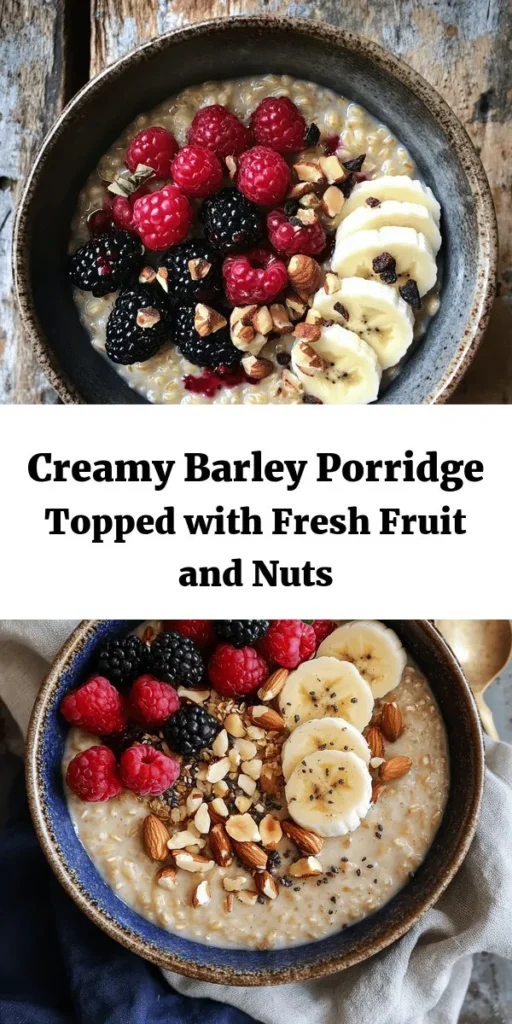Introduction to Warm & Creamy Barley Porridge
Barley porridge is quickly becoming a beloved staple in the breakfast world, and for good reason. This warm and creamy dish not only offers a comforting texture but also packs a punch in terms of nutrition and flavor. As diets increasingly embrace the goodness of whole grains, barley stands out as a versatile option that caters to a variety of palates and dietary preferences. Whether you enjoy it sweet with fruits and honey or savory with herbs and spices, barley porridge is a blank canvas that welcomes creativity and personalization.
What makes this dish particularly appealing is its warm and creamy consistency, perfect for cozy mornings when you crave something hearty and fulfilling. Imagine waking up to a bowl of warm barley porridge, topped with fresh fruits and a drizzle of maple syrup, all while it nourishes your body and comforts your soul. As one of the most ancient grains known to humanity, barley has a rich history that spans thousands of years, and today it is making a strong comeback in modern kitchens.
Understanding Barley: A Nutritional Powerhouse
Barley is not just a tasty grain; it is a nutritional powerhouse that deserves a place in your pantry. This whole grain is incredibly high in dietary fiber, which is essential for maintaining digestive health and promoting regularity. In fact, a single serving of barley can provide nearly 6 grams of fiber, helping you feel full and satisfied throughout the morning. This fiber content also plays a crucial role in supporting heart health by reducing cholesterol levels and promoting healthy blood circulation.
In addition to fiber, barley is rich in essential vitamins and minerals. It contains B vitamins, which are vital for energy metabolism, as well as important minerals such as selenium, magnesium, and iron. These nutrients contribute to overall well-being, supporting everything from bone health to immune function. Furthermore, barley has a low glycemic index, which means it can help stabilize blood sugar levels, making it an excellent choice for those looking to manage their weight or control diabetes.
When compared to other grains, barley stands out for its unique qualities. Unlike refined grains, which have been stripped of their nutrients, barley retains its bran and germ, allowing you to enjoy the full benefits of its natural goodness. This makes barley not only a healthier alternative but also a more satisfying option that keeps you feeling energized and full longer.
Ingredients Breakdown for Barley Porridge
To create a delicious and nutritious bowl of barley porridge, you’ll need a few key ingredients. Each ingredient plays a vital role in shaping the flavor, texture, and nutritional profile of the dish.
Pearl Barley
The star of the show, pearl barley, is a type of whole grain that has been polished to remove its outer hull, giving it a chewy texture that is perfect for porridge. Unlike other grains, pearl barley retains its nutty flavor and provides a satisfying bite. It is also full of essential nutrients, including fiber, protein, and various vitamins and minerals. Using pearl barley as the base for your porridge not only offers a fulfilling meal but also contributes to a balanced diet.
Water or Vegetable Broth
The choice of liquid used to cook your barley is crucial for flavor enhancement. While water is a standard option, using vegetable broth can elevate your porridge by infusing it with rich, savory notes. This is particularly beneficial if you plan to enjoy your porridge in a savory style, as the broth can complement the ingredients beautifully.
Almond Milk (or Milk of Choice)
For those who prefer a creamy consistency, almond milk is an excellent choice. Not only does it add a subtle nutty flavor, but it also keeps the dish dairy-free. However, if you prefer a richer taste, you can opt for whole milk or any other milk of your choice, such as oat or coconut milk. Each type of milk will influence the final texture and flavor of your porridge, so feel free to experiment with what you have on hand.
Maple Syrup (or Honey)
To sweeten your porridge naturally, consider using maple syrup or honey. Both of these options are healthier alternatives to refined sugars, offering a touch of sweetness without the added chemicals. Maple syrup, in particular, contains antioxidants and essential minerals like zinc and manganese, adding to the overall health benefits of your breakfast.
Vanilla Extract and Cinnamon
Adding a splash of vanilla extract and a sprinkle of cinnamon can transform your barley porridge into a delightful treat. Vanilla enhances the overall flavor profile, providing a warm and inviting aroma, while cinnamon adds a hint of sweetness and has been linked to various health benefits, including anti-inflammatory properties and blood sugar regulation.
Fresh Fruit and Nuts
One of the best parts of preparing barley porridge is the opportunity to customize it with your favorite toppings. Fresh fruits such as berries, bananas, or apples not only add natural sweetness and a burst of flavor but also provide essential vitamins and antioxidants. Nuts, on the other hand, contribute healthy fats and protein, making your porridge even more satisfying. The combination of textures—creamy porridge topped with crunchy nuts and juicy fruits—creates a delicious breakfast experience.
Optional Dried Fruits
For an extra layer of flavor and chewiness, you can also incorporate dried fruits such as raisins, cranberries, or apricots. These can be mixed into the porridge while it cooks or sprinkled on top just before serving. Dried fruits can enhance the sweetness of the dish and provide an additional source of fiber and antioxidants.
Step-by-Step Instructions to Prepare Barley Porridge
Now that you have a solid understanding of the ingredients, it’s time to move on to the preparation of your warm and creamy barley porridge. Follow these detailed steps for a perfect bowl of porridge that will warm your heart and nourish your body.
1. Rinse the Pearl Barley: Begin by rinsing 1 cup of pearl barley under cold running water. This helps remove any dust or impurities and ensures that your porridge has a clean, fresh taste.
2. Combine Ingredients: In a medium-sized pot, combine the rinsed barley with 4 cups of water or vegetable broth. If you prefer a creamier texture, you can substitute half of the water or broth with almond milk or your milk of choice.
3. Cook the Barley: Bring the mixture to a boil over medium-high heat. Once boiling, reduce the heat to low, cover the pot, and let it simmer for about 30-40 minutes. Stir occasionally to prevent sticking and ensure even cooking. You’ll know the barley is ready when it becomes tender and has absorbed most of the liquid.
4. Add Sweetness and Flavor: Once the barley is cooked, stir in 2 tablespoons of maple syrup or honey, along with 1 teaspoon of vanilla extract and a sprinkle of cinnamon. Adjust the sweetness to taste, depending on your preference.
5. Incorporate Almond Milk: If you desire an extra creamy consistency, slowly pour in an additional cup of almond milk or your chosen milk alternative. Stir well and let the porridge simmer for another 5 minutes to allow the flavors to meld.
6. Serve and Top: Once your porridge reaches the desired creaminess, remove it from the heat and ladle it into bowls. Top with fresh fruits, nuts, or dried fruits according to your preference. This is where you can get creative and make each bowl unique.
7. Enjoy: Your warm and creamy barley porridge is now ready to be enjoyed. Savor each spoonful of this nutritious breakfast that not only fills your stomach but also nourishes your body.
As you prepare to enjoy your barley porridge, remember that the journey to creating this wholesome dish is just as rewarding as the final result. The combination of flavors, textures, and the nourishing properties of barley make this porridge an exceptional choice for any breakfast table. So, gather your ingredients and get ready to indulge in a comforting bowl of warmth and health.

Rinsing the Barley
Before you begin cooking, it’s essential to rinse the barley thoroughly. This step may seem minor, but it plays a crucial role in ensuring cleanliness and enhancing texture. Barley can sometimes carry dust or debris from the packaging process, which can affect the final taste of your porridge. Rinsing not only removes any impurities but also helps in achieving a better texture during cooking. The rinsing process allows the grains to absorb water more effectively, leading to a creamier porridge. To rinse barley, simply place it in a fine-mesh sieve and run cold water over it, gently agitating the grains with your hand until the water runs clear.
Cooking the Barley
Once rinsed, it’s time to cook the barley. The key to perfect barley porridge lies in balancing the cooking time and the liquid-to-grain ratio. For a creamy texture, use a ratio of 3 cups of water for every 1 cup of rinsed barley. Bring the water to a boil in a medium saucepan, then add the barley. Reduce the heat to low and cover the pot, allowing the barley to simmer gently. Cooking time typically ranges from 30 to 40 minutes, depending on the variety of barley used.
Stir the barley occasionally to prevent sticking and to check the consistency. The goal is to achieve a tender yet chewy texture, so taste testing is recommended. If the barley is too chewy for your liking, add a bit more water and continue simmering until it reaches your desired doneness. Once cooked, remove the pot from the heat and let it sit covered for about 5 minutes to allow the grains to absorb any remaining liquid.
Simmering and Adding Flavor
Simmering is a fundamental step that not only cooks the barley but also allows for flavor infusion. After the initial cooking phase, you can increase the flavor profile of the porridge by adding ingredients such as a pinch of salt, a dash of cinnamon, or even a splash of vanilla extract during the last 10 minutes of cooking. These ingredients will meld into the barley, creating a warm, comforting dish.
If you prefer a creamier consistency, consider stirring in a splash of milk or a dairy-free alternative, such as almond or oat milk, during the final minutes of cooking. This addition will enhance the richness and make your porridge even more delightful. Adjust the amount of liquid according to your preference for thickness; a little extra milk can transform your dish into an indulgent treat.
Preparing Toppings
One of the best aspects of barley porridge is its versatility in toppings. The right toppings can elevate your porridge from a simple breakfast to a gourmet experience. Here are some delicious combinations to consider:
1. Fruits: Fresh seasonal fruits like sliced bananas, berries, or diced apples add natural sweetness and a burst of flavor. Dried fruits such as raisins, cranberries, or apricots also provide a chewy texture and richness.
2. Nuts and Seeds: Sprinkle a handful of chopped nuts like almonds, walnuts, or pecans for added crunch and healthy fats. Seeds such as chia or flaxseeds can also be included for an extra nutritional boost.
3. Sweeteners: Drizzle your porridge with honey, maple syrup, or agave nectar for a touch of sweetness. For a healthier option, consider using stevia or monk fruit sweetener if you prefer to limit sugar intake.
4. Nut Butters: A spoonful of almond or peanut butter swirled into your porridge not only adds creaminess but also ensures a satisfying protein boost.
Serving Suggestions
When it comes time to serve your warm and creamy barley porridge, presentation can enhance the dining experience. Here are some serving ideas that will make your porridge visually appealing:
– Layering: In a bowl, layer the porridge with your chosen toppings. Start with the barley at the bottom, followed by fruits and nuts arranged artfully on top.
– Drizzles: Finish with a drizzle of sweetener or nut butter to create an inviting look. A sprinkle of cinnamon or a few mint leaves can add a pop of color and freshness.
– Custom Bowls: Encourage personalization by setting up a toppings bar. Let your family or guests choose their favorite fruits, nuts, and sweeteners to create their own unique bowls.
Exploring Variations of Barley Porridge
Barley porridge is wonderfully adaptable, allowing for numerous variations and substitutions. Here are some ideas to inspire creativity in your kitchen:
Flavor Variations
Spice up your porridge by incorporating different flavorings. Try adding:
– Nutmeg: A pinch of nutmeg can add warmth and depth, perfect for colder months.
– Cocoa Powder: For a chocolatey twist, mix in cocoa powder and a sweetener of your choice for a dessert-like porridge.
Alternative Sweeteners
If you’re looking to adjust the sweetness, there are plenty of natural sweeteners to explore:
– Agave Syrup: This sweetener dissolves easily in warm porridge and has a low glycemic index.
– Stevia: A zero-calorie sweetener that can be used in small amounts to achieve desired sweetness without added calories.
Different Toppings
Encourage experimenting with various toppings to keep breakfast exciting:
– Seasonal Fruits: Use whatever is in season for the freshest flavors. Consider peaches in summer or pomegranates in fall.
– Nut Butters: Experiment with flavored nut butters, like cashew or sunflower seed butter, for a twist on the classic.
Nutritional Benefits of Barley Porridge
Barley porridge is not just delicious; it also packs a nutritional punch. Here’s a breakdown of its benefits:
Caloric and Macronutrient Breakdown
A typical serving of barley porridge (approximately 1 cup cooked) contains about:
– Calories: 150-200 calories, depending on added ingredients.
– Carbohydrates: 30-35 grams, primarily from whole grains.
– Protein: 4-5 grams, offering a great start to your day.
– Fiber: 6-8 grams, which aids in digestion and promotes fullness.
Vitamins and Minerals
Barley is rich in essential vitamins and minerals, including:
– B Vitamins: Important for energy metabolism and brain health.
– Iron: Crucial for oxygen transport in the blood.
– Magnesium: Supports muscle and nerve function.
This porridge fits seamlessly into various dietary needs, being naturally vegan and easily adaptable for gluten-free diets when using certified gluten-free barley.
The Importance of Whole Grains in Your Diet
Incorporating whole grains like barley into your daily meals is essential for maintaining a balanced diet. Whole grains are known for their numerous health benefits, which include:
– Heart Health: Regular consumption of whole grains can lower the risk of heart disease by improving cholesterol levels and reducing blood pressure.
– Weight Management: Whole grains are high in fiber, promoting satiety and helping to control appetite, which can assist in weight management.
– Digestive Health: The fiber content in whole grains supports digestive health by promoting regular bowel movements and preventing constipation.
Dietary guidelines recommend that at least half of your grain intake should come from whole grains. Barley porridge not only meets these requirements but also provides a comforting and nutritious option for breakfast.
Conclusion: Embracing Warm & Creamy Barley Porridge
In summary, warm and creamy barley porridge is a nourishing dish that can easily become a staple in your breakfast rotation. With its versatility and health benefits, barley porridge is a delicious way to start your day. From the importance of rinsing and cooking to the endless topping possibilities, this recipe allows for creativity and personalization.
Embrace the warm, comforting qualities of barley porridge, and enjoy the journey of customizing your bowl to suit your tastes. Whether you stick to the classic recipe or explore various flavor combinations and toppings, you’ll be rewarded with a satisfying meal that supports your health and wellness goals. Try incorporating this wholesome dish into your routine and experience the deliciousness for yourself.



